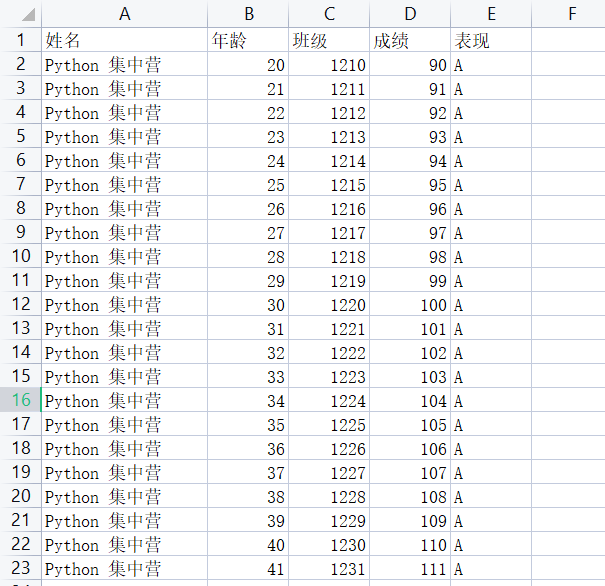Python Excel資料處理之xlrd/xlwt/xlutils模組怎麼使用
常規的Excel資料處理中,就是對Excel資料檔案的讀/寫/檔案物件操作。
透過對應的python非標準函式庫xlrd/xlwt/xlutils,來實現具體的資料處理業務邏輯。
在複雜的Excel業務資料處理中,三兄弟扮演的角色缺一不可。今天我們的內容是關於如何採用xlrd/xlwt/xlutils三個模組來實現資料處理。
1、模組說明
使用該三個模組來處理Excel資料最好的地方就是他們和Excel檔案物件對應的資料處理概念是一樣的,能更好的便於我們理解數據對象。
首先,這三個模組都是python的非標準函式庫,可以選擇pip的方式來進行安裝。
pip install xlrd pip install xlwt pip install xlutils
以下是我們為示範資料處理的過程所準備的來源資料內容,只是用來測試。

xlrd:用於讀取Excle資料檔案將傳回的資料物件放到記憶體中,然後查詢資料檔案物件的相關資訊。
xlwt:用於在記憶體中產生新的資料檔案對象,處理完成後寫入到Excel資料檔中。
xlutils:主要的作用就是copy新的文件對象,在新的資料對像中完成資料處理操作。
將xlrd/xlwt/xlutils三個模組分別都匯入到待開發的程式碼區塊中提供支援。
# Importing the xlrd module. import xlrd as read # Importing the xlwt module. import xlwt as write # Copying the contents of the original workbook into a new workbook. from xlutils.copy import copy
2、xlrd處理
# Opening the workbook and assigning it to the variable `work_book`.
work_book = read.open_workbook('D:/test-data-work/test.xls')
# Assigning the sheet named 'Sheet1' to the variable `sheet`.
sheet = work_book.sheet_by_name('Sheet1')
# `row = sheet.nrows` is assigning the number of rows in the sheet to the variable `row`.
row = sheet.nrows
# `col = sheet.ncols` is assigning the number of columns in the sheet to the variable `col`.
col = sheet.ncols
print('Sheet1工作表有:{0}行,{1}列'.format(str(row), str(col)))
# Sheet1工作表有:23行,5列以下是三種常用的sheet物件的資料遍歷方式,分別是按行/列的方式進行資料遍歷。
for a in sheet.get_rows():
print(a)
# [text:'姓名', text:'年龄', text:'班级', text:'成绩', text:'表现']
# [text:'Python 集中营', number:20.0, number:1210.0, number:90.0, text:'A']
# [text:'Python 集中营', number:21.0, number:1211.0, number:91.0, text:'A']
# [text:'Python 集中营', number:22.0, number:1212.0, number:92.0, text:'A']
# [text:'Python 集中营', number:23.0, number:1213.0, number:93.0, text:'A']
# [text:'Python 集中营', number:24.0, number:1214.0, number:94.0, text:'A']
# [text:'Python 集中营', number:25.0, number:1215.0, number:95.0, text:'A']
# [text:'Python 集中营', number:26.0, number:1216.0, number:96.0, text:'A']
# [text:'Python 集中营', number:27.0, number:1217.0, number:97.0, text:'A']
# [text:'Python 集中营', number:28.0, number:1218.0, number:98.0, text:'A']
# [text:'Python 集中营', number:29.0, number:1219.0, number:99.0, text:'A']
# [text:'Python 集中营', number:30.0, number:1220.0, number:100.0, text:'A']
# [text:'Python 集中营', number:31.0, number:1221.0, number:101.0, text:'A']
# [text:'Python 集中营', number:32.0, number:1222.0, number:102.0, text:'A']
# [text:'Python 集中营', number:33.0, number:1223.0, number:103.0, text:'A']
# [text:'Python 集中营', number:34.0, number:1224.0, number:104.0, text:'A']
# [text:'Python 集中营', number:35.0, number:1225.0, number:105.0, text:'A']
# [text:'Python 集中营', number:36.0, number:1226.0, number:106.0, text:'A']
# [text:'Python 集中营', number:37.0, number:1227.0, number:107.0, text:'A']
# [text:'Python 集中营', number:38.0, number:1228.0, number:108.0, text:'A']
# [text:'Python 集中营', number:39.0, number:1229.0, number:109.0, text:'A']
# [text:'Python 集中营', number:40.0, number:1230.0, number:110.0, text:'A']
# [text:'Python 集中营', number:41.0, number:1231.0, number:111.0, text:'A']
for b in range(row):
print(sheet.row_values(b))
# ['姓名', '年龄', '班级', '成绩', '表现']
# ['Python 集中营', 20.0, 1210.0, 90.0, 'A']
# ['Python 集中营', 21.0, 1211.0, 91.0, 'A']
# ['Python 集中营', 22.0, 1212.0, 92.0, 'A']
# ['Python 集中营', 23.0, 1213.0, 93.0, 'A']
# ['Python 集中营', 24.0, 1214.0, 94.0, 'A']
# ['Python 集中营', 25.0, 1215.0, 95.0, 'A']
# ['Python 集中营', 26.0, 1216.0, 96.0, 'A']
# ['Python 集中营', 27.0, 1217.0, 97.0, 'A']
# ['Python 集中营', 28.0, 1218.0, 98.0, 'A']
# ['Python 集中营', 29.0, 1219.0, 99.0, 'A']
# ['Python 集中营', 30.0, 1220.0, 100.0, 'A']
# ['Python 集中营', 31.0, 1221.0, 101.0, 'A']
# ['Python 集中营', 32.0, 1222.0, 102.0, 'A']
# ['Python 集中营', 33.0, 1223.0, 103.0, 'A']
# ['Python 集中营', 34.0, 1224.0, 104.0, 'A']
# ['Python 集中营', 35.0, 1225.0, 105.0, 'A']
# ['Python 集中营', 36.0, 1226.0, 106.0, 'A']
# ['Python 集中营', 37.0, 1227.0, 107.0, 'A']
# ['Python 集中营', 38.0, 1228.0, 108.0, 'A']
# ['Python 集中营', 39.0, 1229.0, 109.0, 'A']
# ['Python 集中营', 40.0, 1230.0, 110.0, 'A']
# ['Python 集中营', 41.0, 1231.0, 111.0, 'A']
for c in range(col):
print(sheet.col_values(c))
# ['姓名', 'Python 集中营', 'Python 集中营', 'Python 集中营', 'Python 集中营', 'Python 集中营', 'Python 集中营', 'Python 集中营', 'Python 集中营', 'Python 集中营', 'Python 集中营', 'Python 集中营', 'Python 集中营', 'Python 集中营', 'Python 集中营', 'Python 集中营', 'Python 集中营', 'Python 集中营', 'Python 集中营', 'Python 集中营', 'Python 集中营', 'Python 集中营', 'Python 集中营']
# ['年龄', 20.0, 21.0, 22.0, 23.0, 24.0, 25.0, 26.0, 27.0, 28.0, 29.0, 30.0, 31.0, 32.0, 33.0, 34.0, 35.0, 36.0, 37.0, 38.0, 39.0, 40.0, 41.0]
# ['班级', 1210.0, 1211.0, 1212.0, 1213.0, 1214.0, 1215.0, 1216.0, 1217.0, 1218.0, 1219.0, 1220.0, 1221.0, 1222.0, 1223.0, 1224.0, 1225.0, 1226.0, 1227.0, 1228.0, 1229.0, 1230.0, 1231.0]
# ['成绩', 90.0, 91.0, 92.0, 93.0, 94.0, 95.0, 96.0, 97.0, 98.0, 99.0, 100.0, 101.0, 102.0, 103.0, 104.0, 105.0, 106.0, 107.0, 108.0, 109.0, 110.0, 111.0]
# ['表现', 'A', 'A', 'A', 'A', 'A', 'A', 'A', 'A', 'A', 'A', 'A', 'A', 'A', 'A', 'A', 'A', 'A', 'A', 'A', 'A', 'A', 'A']3、xlwt處理
# Creating a new workbook.
work_book_2 = write.Workbook()
# Creating a new sheet named 'Sheet4' in the workbook.
sheet_2 = work_book_2.add_sheet('Sheet4')
list = [
['姓名', '年龄', '班级', '成绩'],
['张三', '20', '1210', '89'],
['李四', '21', '1211', '90'],
['王五', '22', '1212', '91'],
]
for row_index in range(4):
for col_index in range(4):
sheet_2.write(row_index, col_index, list[row_index][col_index])
col_index += 1
row_index += 1
# Saving the workbook to the specified location.
work_book_2.save('D:/test-data-work/test2.xls')4、xlutils處理
# Opening the workbook and assigning it to the variable `work_book_3`. work_book_3 = read.open_workbook('D:/test-data-work/test.xls') # Copying the contents of the original workbook into a new workbook. work_book_3_copy = copy(work_book_3) # Saving the contents of the original workbook into a new workbook. work_book_3_copy.save('D:/test-data-work/test3.xls')
以上是Python Excel資料處理之xlrd/xlwt/xlutils模組怎麼使用的詳細內容。更多資訊請關注PHP中文網其他相關文章!

熱AI工具

Undresser.AI Undress
人工智慧驅動的應用程序,用於創建逼真的裸體照片

AI Clothes Remover
用於從照片中去除衣服的線上人工智慧工具。

Undress AI Tool
免費脫衣圖片

Clothoff.io
AI脫衣器

Video Face Swap
使用我們完全免費的人工智慧換臉工具,輕鬆在任何影片中換臉!

熱門文章

熱工具

記事本++7.3.1
好用且免費的程式碼編輯器

SublimeText3漢化版
中文版,非常好用

禪工作室 13.0.1
強大的PHP整合開發環境

Dreamweaver CS6
視覺化網頁開發工具

SublimeText3 Mac版
神級程式碼編輯軟體(SublimeText3)
 PHP和Python:解釋了不同的範例
Apr 18, 2025 am 12:26 AM
PHP和Python:解釋了不同的範例
Apr 18, 2025 am 12:26 AM
PHP主要是過程式編程,但也支持面向對象編程(OOP);Python支持多種範式,包括OOP、函數式和過程式編程。 PHP適合web開發,Python適用於多種應用,如數據分析和機器學習。
 在PHP和Python之間進行選擇:指南
Apr 18, 2025 am 12:24 AM
在PHP和Python之間進行選擇:指南
Apr 18, 2025 am 12:24 AM
PHP適合網頁開發和快速原型開發,Python適用於數據科學和機器學習。 1.PHP用於動態網頁開發,語法簡單,適合快速開發。 2.Python語法簡潔,適用於多領域,庫生態系統強大。
 sublime怎麼運行代碼python
Apr 16, 2025 am 08:48 AM
sublime怎麼運行代碼python
Apr 16, 2025 am 08:48 AM
在 Sublime Text 中運行 Python 代碼,需先安裝 Python 插件,再創建 .py 文件並編寫代碼,最後按 Ctrl B 運行代碼,輸出會在控制台中顯示。
 PHP和Python:深入了解他們的歷史
Apr 18, 2025 am 12:25 AM
PHP和Python:深入了解他們的歷史
Apr 18, 2025 am 12:25 AM
PHP起源於1994年,由RasmusLerdorf開發,最初用於跟踪網站訪問者,逐漸演變為服務器端腳本語言,廣泛應用於網頁開發。 Python由GuidovanRossum於1980年代末開發,1991年首次發布,強調代碼可讀性和簡潔性,適用於科學計算、數據分析等領域。
 Python vs. JavaScript:學習曲線和易用性
Apr 16, 2025 am 12:12 AM
Python vs. JavaScript:學習曲線和易用性
Apr 16, 2025 am 12:12 AM
Python更適合初學者,學習曲線平緩,語法簡潔;JavaScript適合前端開發,學習曲線較陡,語法靈活。 1.Python語法直觀,適用於數據科學和後端開發。 2.JavaScript靈活,廣泛用於前端和服務器端編程。
 Golang vs. Python:性能和可伸縮性
Apr 19, 2025 am 12:18 AM
Golang vs. Python:性能和可伸縮性
Apr 19, 2025 am 12:18 AM
Golang在性能和可擴展性方面優於Python。 1)Golang的編譯型特性和高效並發模型使其在高並發場景下表現出色。 2)Python作為解釋型語言,執行速度較慢,但通過工具如Cython可優化性能。
 vscode在哪寫代碼
Apr 15, 2025 pm 09:54 PM
vscode在哪寫代碼
Apr 15, 2025 pm 09:54 PM
在 Visual Studio Code(VSCode)中編寫代碼簡單易行,只需安裝 VSCode、創建項目、選擇語言、創建文件、編寫代碼、保存並運行即可。 VSCode 的優點包括跨平台、免費開源、強大功能、擴展豐富,以及輕量快速。
 notepad 怎麼運行python
Apr 16, 2025 pm 07:33 PM
notepad 怎麼運行python
Apr 16, 2025 pm 07:33 PM
在 Notepad 中運行 Python 代碼需要安裝 Python 可執行文件和 NppExec 插件。安裝 Python 並為其添加 PATH 後,在 NppExec 插件中配置命令為“python”、參數為“{CURRENT_DIRECTORY}{FILE_NAME}”,即可在 Notepad 中通過快捷鍵“F6”運行 Python 代碼。






